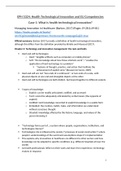EPH 1024: Health Technological Innovation and EU Competencies
Case 1: What is health technological innovation?
Managing Innovation in Healthcare (Barlow, 2017) (Pages 19-28 & 69-81)
https://books.google.nl/books?
id=rEQyDwAAQBAJ&printsec=frontcover#v=onepage&q&f=true
Official summary: Barlow (2017) provide a definition of health technological innovation,
although this differs from the definition provided by Kimble and Massoud (2017).
Chapter 2: Technology and innovation management: the nuts and bolts
Hard and soft technologies
o Hard: “tangible artifacts such as computers or mobile phones”
o Soft: “the knowledge about how those artefacts work” / “enables the
application of hard technology to a problem”
“Systems of thought, practice, and action that facilitate the
achievement of explicit aims” (Bessant & Francis, 2005)
Hard and soft are not “two ends of a continuum”, or two ends of a scale, with
physical objects at one end and intangible objects at the other
Hard and soft technologies are both distinct, but bound together to different extents
5 types of knowledge:
o Explicit: can be readily articulated, codified, and accessed
o Tacit: cannot be adequately articulated by verbal means (the opposite of
explicit)
o Codified: tacit knowledge converted to explicit knowledge in a usable form
o Embodied: the routines, habits, tasks, and information we understand
without conscious thought
o Situated: knowledge affected by the history, language, and values of the
person knowing it
“Technology forms part of…a system where people, organisations, institutions, and
technologies interact”
Technologies role is influenced by society (“processes of social construction”) where
people’s understandings of the world and assumptions shape it’s implementation
This explains why innovations in healthcare are different to other sectors and how
knowledge can be adapted to specific conditions (e.g. different hospitals all over the
world)
As health professionals reflect on their work and learn from experience, technology
evolves in response
1
, This can make implementation and impact of technology challenging and
unpredictable
Technology determinism
Determinism: all events are completely determined by previously existing causes
In technology, the combustion engine in the 19th century still shapes cars in the 21st
century, or how we persist with the QWERTY keyboard layout despite it’s
inefficiencies for English speakers
“Technology is built and used within certain social and historical circumstances and
its form and functioning will bear the imprint of these conditions” (Orlikowski, 1992)
A technology will have legacy and contemporary influences (e.g. In WWII, artillery
still paused before firing – a routine introduced in the past to “hold the horses”
before the loud noise - despite no horses being used in warfare anymore)
Why we need to be more precise in our definitions of ‘innovation’
“Viewing innovation as a discrete product is often characteristic of the research
literature on adoption, while viewing it as a process is more associated with research
on implementation” (Rye & Kimberly, 2007)
“Arguably there is still an overemphasis on the aspects of innovation that relate to
the creation of new products and bringing them to a commercial market”
There is insufficient emphasis on innovation on the public sector, despite it being
where a majority of healthcare is provisioned
Innovation contains 2 dimensions:
2
, o Creative: the invention
o Commercial / Practical: the exploitation of the invention
Therefore, an invention is not the same as an innovation; many inventions do not get
implemented (commercial/practical dimension)
It’s important to consider if an innovation changes individual components in a
system, or the whole system
Innovations can come from 2 sources:
o Push: something new where there was no previous demand (e.g. e-books)
o Pull: a specific demands exists (e.g. reducing costs or improving
safety/quality)
o The best innovations are a mix of the two
Chapter 3: Innovation in healthcare – a special case?
Healthcare has several distinctive features that influence its innovation processes:
o The nature of healthcare technology and innovation
“Most healthcare innovations involve a combination of ‘soft’ and
‘hard’ elements…and are often both ‘process’ and ‘service’
innovations”
“One innovation can mutate and be adapted in different local,
national or organisational contexts”
o A risk-averse culture and extensive regulation
“A lengthy process of experimentation and legitimation”
Different applications of an innovation mean different measures of it’s
efficacy to different people
o The economics and politics of healthcare
3
, Payments in healthcare are made by individuals, insurers, and
governments
Politics is central is how healthcare is planned, regulated, and
financed
Politicians often prefer quick wins over long-term innovations, but
innovations often take time for their full effects and benefits to be
visible
This means making a profit from an innovation can be difficult
o The environment new technologies and innovations are adopted and
implemented is extremely complex
Many stakeholders means decisions are complex
Responsibility for adoption and implementation of innovations can be
shared broadly
What is healthcare technology and healthcare innovation?
Healthcare technology goes beyond medical equipment and drugs
Healthcare technology is ‘socially constructed’ as it evolves over time within its
context
“New technologies fit within an existing legacy of hard and soft technologies, and
institutional structures”
o Policies and technologies are layered on top of each other, influencing the
adoption and implementation of new technology
Sometimes reconfiguration is needed to effectively adopt an innovation
What do healthcare innovations typically look like?
Healthcare innovations “may consist of some hard technology, but a lot of soft
technology such as new service delivery models or organisational changes, and they
may be trying to tackle multiple objectives”
Therefore the “adoption of innovations into mainstream healthcare practice is by no
means straightforward” – “it might be understood in different ways by those
involved in implementing and using it”
What do we mean by innovation in healthcare? (Kimble & Massoud, 2017)
https://www.emjreviews.com/innovations/article/what-do-we-mean-by-
innovation-in-healthcare/#:~:text=This%20definition%20includes%20'new
%20or,that%20result%20in%20improved%20healthcare.
Official summary: Kimble and Massoud (2017) provide a definition of health technological
innovation, although this differs from the definition provided by Barlow (2017).
“Innovation denotes new, better, more effective ways of solving problems”
4





